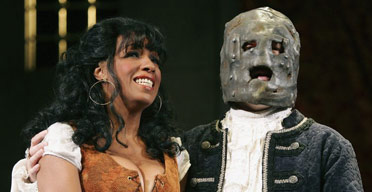
Too Close to the Sun
Comedy Theatre
* (One star)
According to the press materials, Too Close to the Sun is a “dramatic new musical... account of what might have been Ernest Hemingway’s last challenge”. I think the phrase “what might have been” will very soon come to haunt this doomed enterprise.
Flicking through the programme, trying to fight off waves of giggles and pervasive boredom during the first act of this evening’s preview, I struggled to find the name of which misguided producer had financed this disaster of a show. I finally set eyes upon the name “GBM Productions”, which, according to their website (for they didn’t have a biography in the brochure) exists only to produce the work of the composer, John Robinson.
John Robinson and GBM’s previous foray into the West End was as composer and producer of The Man Behind the Iron Mask which, when it opened at the Duchess Theatre in 2005, was greeted by The Guardian newspaper with a one-star review concluding with the words: “the sheer ineptitude of the evening bears all the hallmarks of the West End equivalent of vanity publishing. In this case it is not just a vanity project but a calamity project”. Charles Spencer of the Telegraph spared no punches: he proclaimed “It's so bad that it is merely unendurable… relentlessly, agonisingly third-rate” with a cast that "perform as if they have been on a prolonged Mogadon bender".
[Image: Man Behind the Iron Mask, from Guardian Unlimited]
Keeping his head down after the Dumas fracas, Robinson seems to have spent the last four years preparing this next show, a musical retelling the days running up to the suicide of the Nobel and Pulitzer Prize winning American writer, Ernest Hemingway. With Press Night a week away, I hope GBM and Robinson are prepared for another onslaught. This evening, my friend and I imagined it might have been a lot less painful all around had Hemingway turned the gun on himself (or us) during the overture and saved a lot of bother all round.
For what it’s worth, Too Close to the Sun is a fictional account by Ron Read with lyrics by Roberto Trippini and Robinson himself. It is laid on thick that Hemingway is an aging lothario whose ill-health and vices including liquor and hunting with guns (cue Act II) are only kept at bay by his stern fourth wife Mary, played by Helen Dallimore (better known to West End audiences as a squeaky Glinda the Good). I say laid on thick, as the aging is emphasised in an excruciating opening number Think Good Thoughts sung monotonously by West End veteran James Graeme as Hemingway, whilst straining to act a keep-fit regime and contemplating the transparency of his own urine [sic].
His aging, infidelities and fondness for hunting are then together underlined in an incomprehensible and unintentionally hilarious perfunctory scene in which a wittering Hemingway dismantles and reassembles a shotgun (did I mention what happens at the end?) whilst blindfolded and soliloquizing about where and when in the past something or other had happened as if to indicate a struggle with dementia and depression. Bizarre.
But what an exciting life we are meant to think Hemingway has had, soaring, Icarus-like Too Close to the Sun. What a shame that the pre-interval title number, performed by our leading man straining on his knees and clutching an as yet unconsumed bottle of whisky, is as unmemorable and lacklustre as most of the music which preceded it.
Also living in the transparent, wooden-framed, trophy-clad, revolving ranch is Louella, introduced with a secret smooch and her song The Sentimental Small-Towner That I Am. She is an underemployed assistant, played by American actress Tammy Joelle, whose sirenian presence is barely tolerated by Ernest’s wife. And just to mix things up a bit, an old school friend and all-round rake Rex is invited to stay and is seeking the rights to produce a film of Hemingway’s life – tonight he was played by red-faced understudy Christopher Howell. It turns out that Rex has had his way with both Louella and Mary (the latter, reminiscing in a Spanish themed number Havana which for me rather evoked the Lambada), though his real purpose, I guess, is to provide some gobbet of plot in this otherwise dreary set-up. He also provided some colour, though his musical numbers, including I like to be liked and Hollywood! Hollywood! are incongruous.
I’d love to tell you how it all pans out… but after seventy minutes of this tripe I couldn’t take any more and snuck out at the interval. I guess from the programme that Forgive Me, Wife. You’ll Understand is the moment of Ernest’s extinction, given that it is followed by the remaining characters’ The Regret and I Did My Best.
The press release concludes “in this suggested account of events leading to Hemmingway's death, can there be any winners?”. Unless there’s a miracle before the Press opening, this may yet prove a shorter run than The Man Behind The Iron Mask, which closed after just eighteen days (?22 performances). Ticket prices are up to £52.50. Don’t do it.
